Cobweb mold in mushroom growing: symptoms, prevention and treatment guide
What is cobweb mold
Cobweb is a fungal disease of commercially and home cultivated mushrooms. It isn’t just one species of mold — it is a family of mold species. Each type of web mold is so similar to its relatives that they can only be distinguished by genetic testing.
Cobweb contamination can be caused by several related pathogens: Dactylium, Dactylium dendroides, Cladobotryum dendroides, Cladobotryum mycophilum, Hypomyces or Hypomyces Rosellus etc.
This mold affect magic mushrooms, edible gourmet and wild mushrooms.
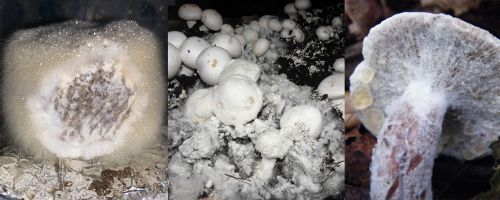
Symptoms of disease can appear on the very first steps of mushroom cultivation. For example, in spawn jars during colonization period.
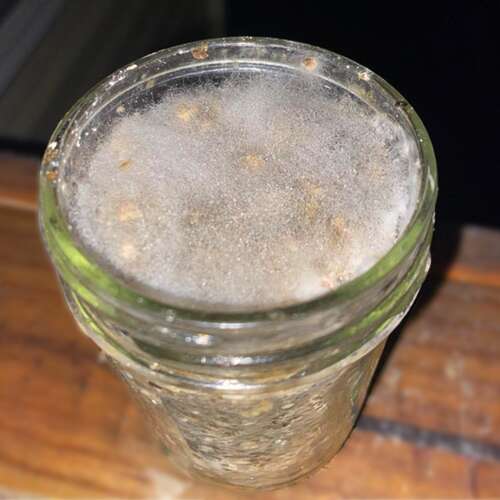
During pinhead initiation and fruiting period, when pins and primordia start their active development.
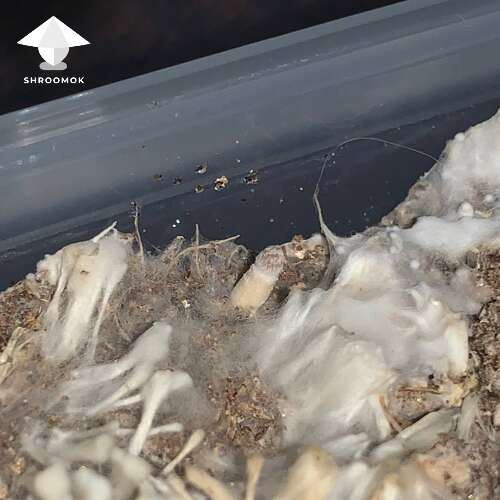
Did you know? Cobweb spores can "sleep" in casing layer for a long time and wait for the favorable conditions to activate them. That's why cobweb most often develops in later flushes.
How to identify cobweb mold
It appears on the casing layer as small white spots. Like cottony areas. Soon cobweb envelopes mushroom mycelium, pinheads and even small fruit bodies with a soft fluffy mold mycelium that causes a soft rot.
Let's figure out main indicators of cobweb contamination.
The main symptom — cobweb mold is darker than mushroom mycelium. It has gray mycelium compared to snow-white mushroom mycelium
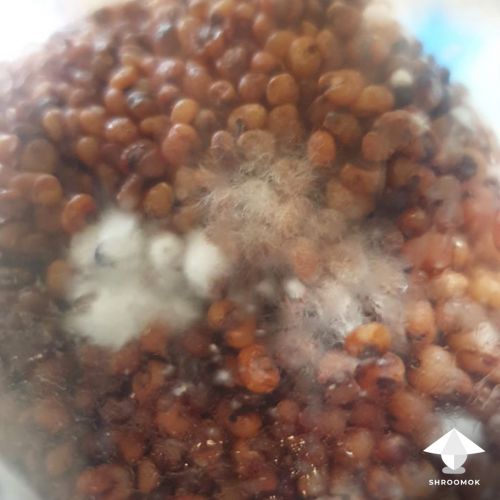
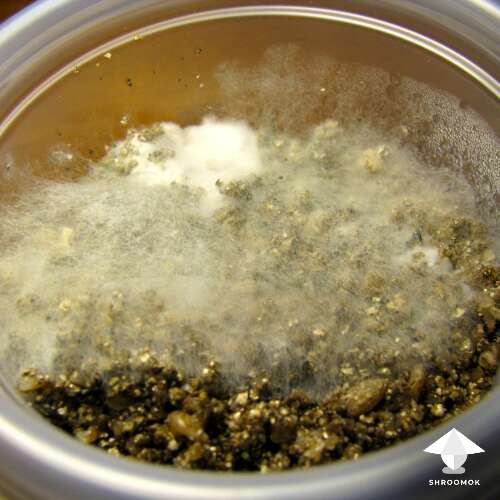
The speed of growth is particularly striking. Cobweb grows incredibly quickly, colonizing the mycelium and mushrooms in its path. A small patch, the size of a coin, grows over the entire top layer just in 1-2 day and turns into fluffy layer.
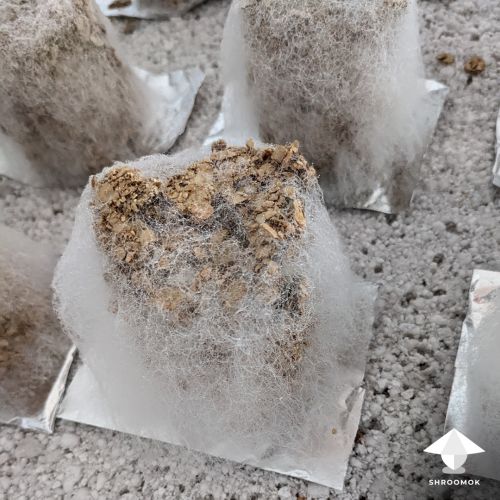
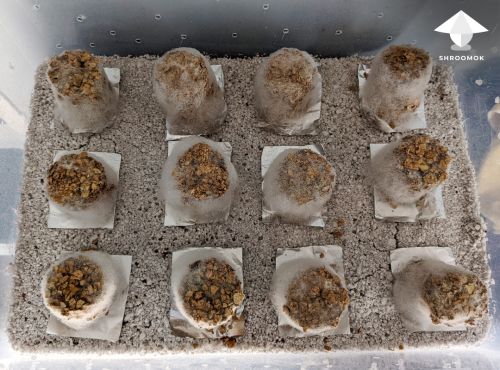
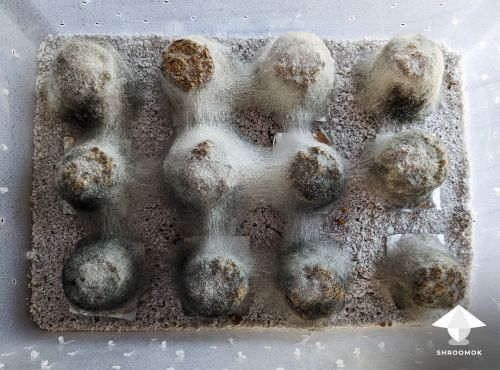
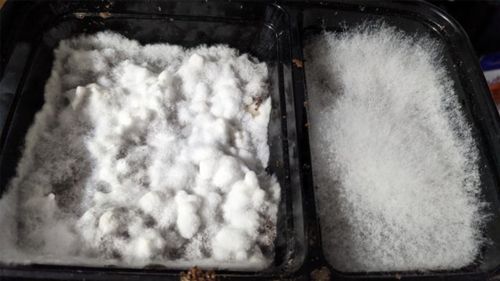
Cobweb mold has very thin hyphae, while mycelium tends to be thicker ropes. Cobweb is almost transparent.
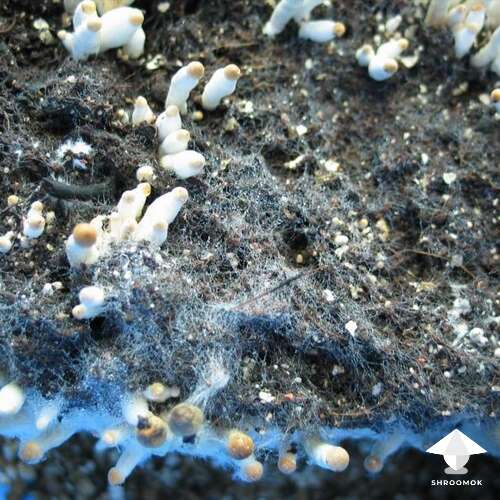
Cobweb often appears on bald uncolonized areas without mushroom mycelium.
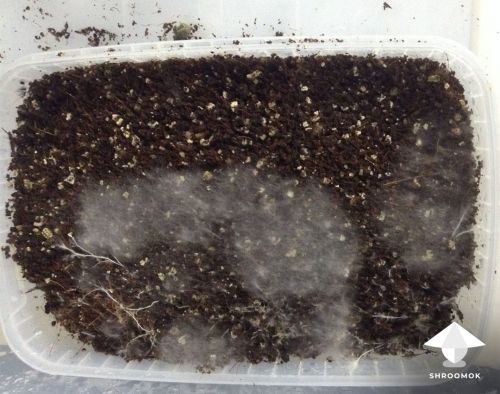
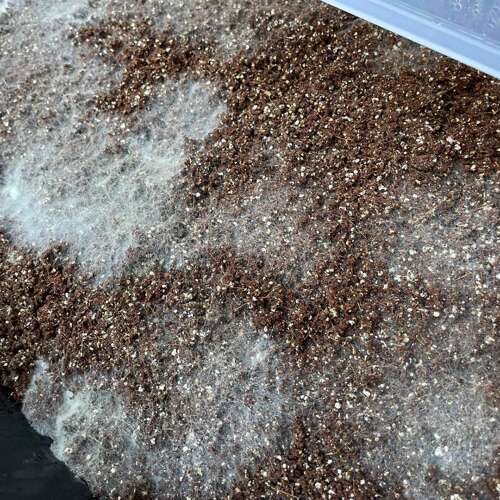
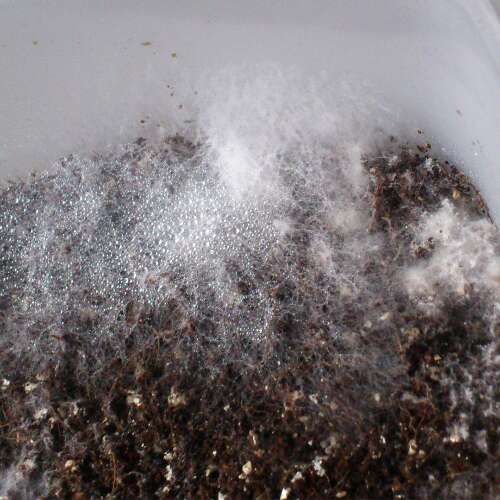
In the later stages of disease, when the mold releases spores, it turns red-purple and then yellow or orange.
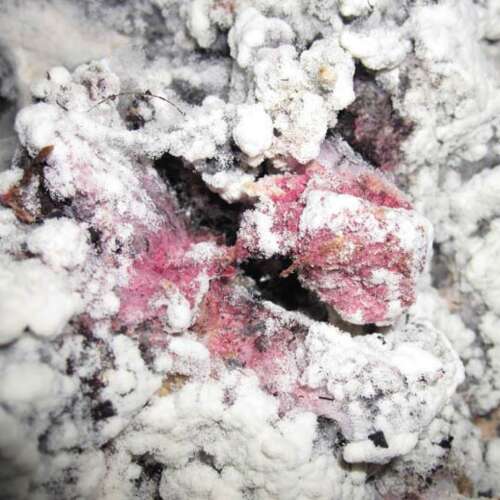
❗️ Such bright rich colors distinguish cobweb from another very similar group of molds called Black Pin Mold. It has black beads at the tips when releases spores.
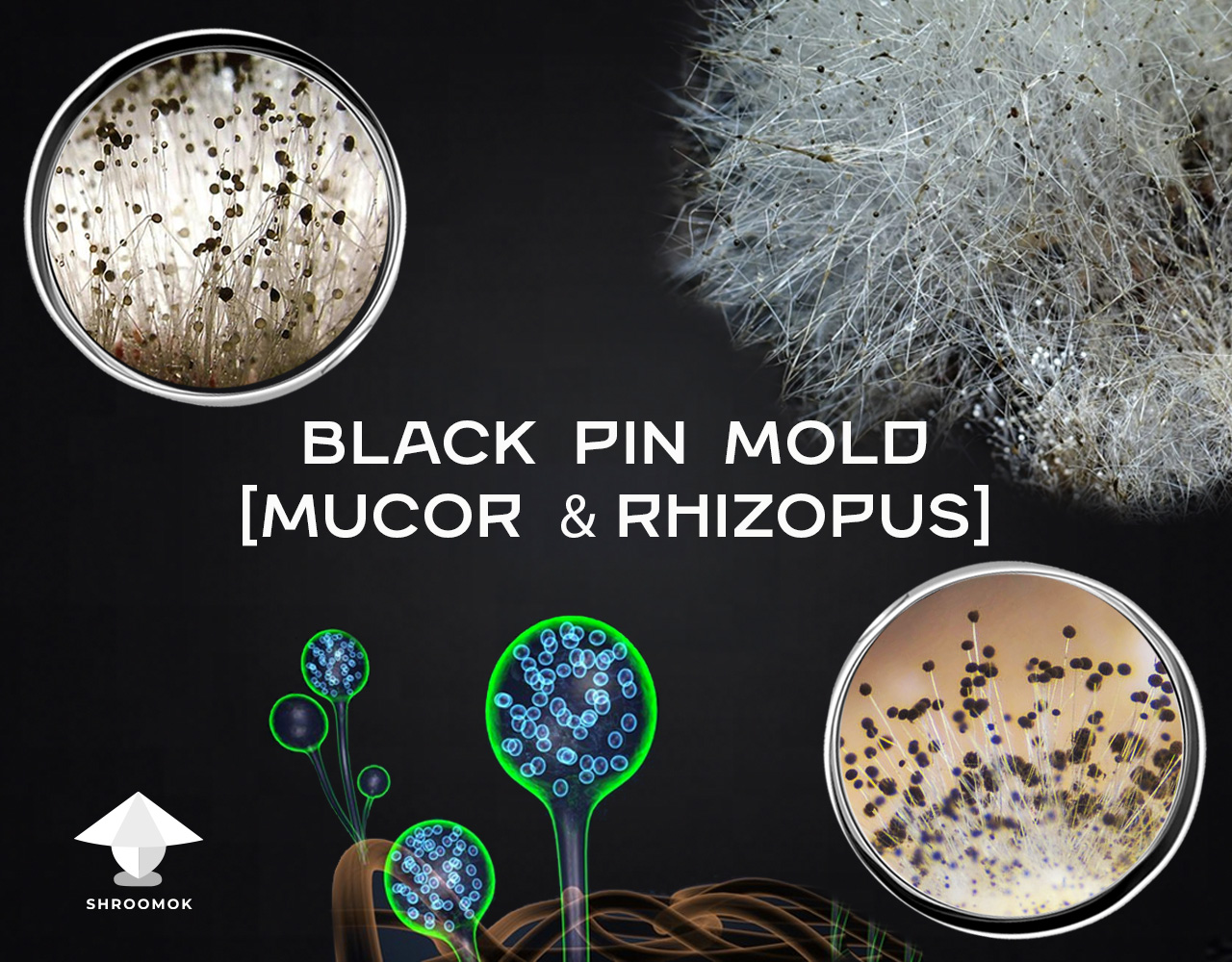
Check out details and photo examples here: Black Pin Mold (Mucor and Rhizopus)
Cobweb Mold or Mushroom Mycelium
Color and hyphae differences of mold and mushroom mycelium are hard to identify for newbie growers haven't seen them side by side before. Your job is to know which is which. Let's figure out a few illustrative cases.
Mycelium and mushroom cake looks grey, because the top layer is dry out. That's why mycelium have blue-grey color. There is no cobweb disease! Such mushroom cakes need rehydration.
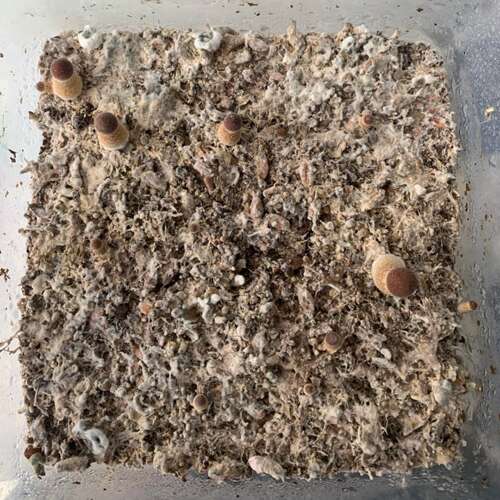
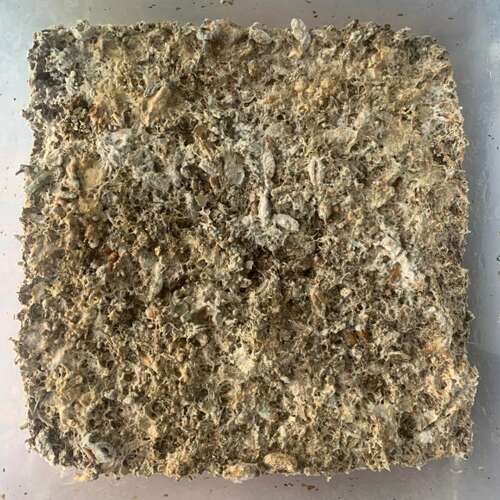
Confusing bluish reaction of magic mushroom mycelium with mold. It’s not contamination!
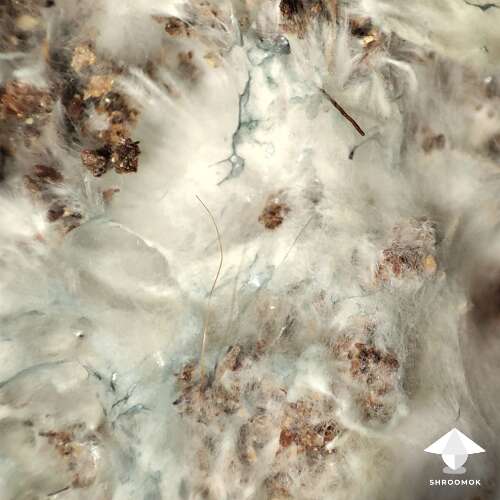
More examples of mycelium bruising here: Mycelium Bruises or Mold Contamination
A common mistake to misidentify a weak strain of mycelium as being cobweb mold. In fact everything is good in the example below! Photo shows a healthy mycelium of different types (tomentose and rhizomorphic mix).
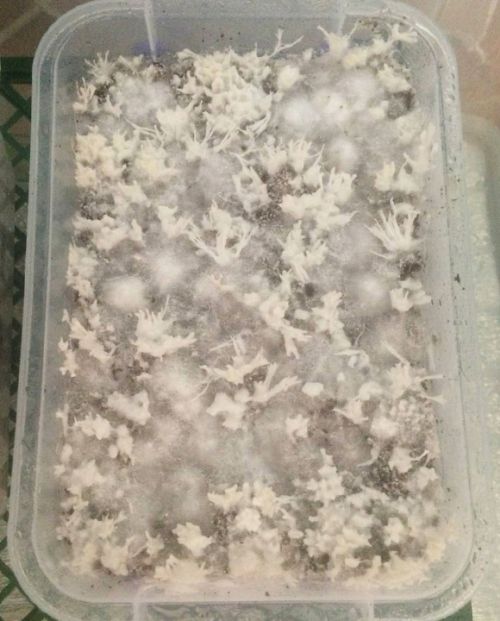
Fuzzy feet is a symptom of lack of fresh air exchange, but it’s not a cobweb contamination.
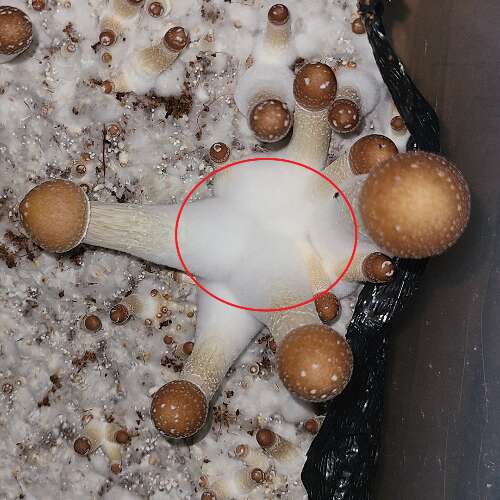
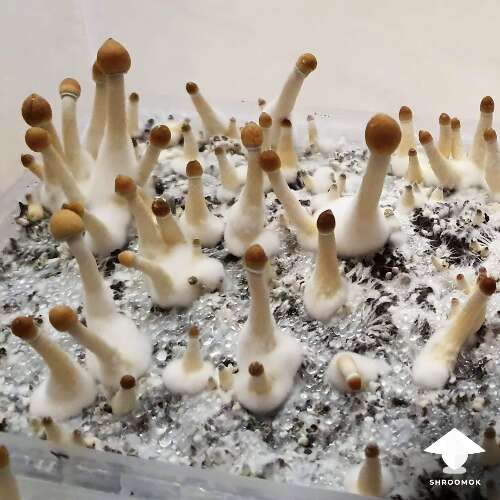
Recommended: Why Mushrooms too Leggy, Fuzzy Feet and White Dots on Caps
Main causes of Cobweb Mold
Lack of FAE (fresh air exchange). Cobweb molds enjoy stagnant air. Mushroom mycelium need fresh air. Here is one more reason why we need to ventilate our fruiting chamber. It’s not only because of the high CO2 level, it’s also because all molds like stale air.
«Dead zones» in the monotube. As a result, insufficient fresh air exchange. Make monotube properly with correct air vents.
Cobweb molds are favored by high relative humidity in stagnant air.
Cobweb like combination of high relative humidity (90% and above) + high temperature (+23°C or 74°F and above) + lack of fanning (less than 3 times/day for growbox or monotube with dead areas).
During spore-forming, cobweb is easily spread in the air and during growbox misting. Moreover, cobweb is easily spread by spores and pieces of mycelium, which stick to your clothes or tools.
Poor sterility. Including environment, workspace, tools, bulk substrate, presence of animal hair, insects, parasites and even cultivator (hand, clothes etc) can carry mold spores.
During sporulating phase mold easily spreads in the air when you introducing fresh air and misting growbox or monotube.
Mushroom aborts is another common point of origin for cobweb mold. There is a clear a correlation between the development of cobweb mold and the presence aborts. However, it is hard to say that the aborts are the direct cause of cobweb disease or even if the cobweb mold was the underlying cause of the aborts.
Preventive measures of cobweb disease
Preventive measures are always the best treatment!
Sterilize or pasteurize bulk substrate, because it may contain spores of cobweb mold. In fact it's very easy to kill this mold. At a temperature of +50°C or 122°F for 30 minutes cobweb spores die. This means that cobweb can easily be prevented by proper sterilization or pasteurization.
Keep all mycological manipulations as sterile as possible.
Maintain favorable fruiting conditions: fresh air exchange, temperature, humidity, light. Remember, spores of cobweb mold can sleep for a long time in casing layer, but as soon as you have stagnant air in fruiting chamber mold is there.
Remove all mushroom aborts any time you are harvesting mushrooms.
Cobweb mold treatment
What to do if mold has ALREADY appeared on your mushroom cake?
The best and most common advice for treating any kind of mold is «Throw it away immediately! Avoid spreading spores in the air and on healthy mushroom cakes!»
But we have good news that give us hope!
Actually, cobweb is considered a treatable disease. It is one of the few molds which can be slowed down or even destroyed with 3% hydrogen peroxide solution (Н2О2)
Remember! Bright color is a late-stage for any kind of mold. The color indicates a sporulation process that is no longer treatable and is a huge risk of spreading contamination. It's too late for treatment!

Treatment is possible in the presence of mild contamination and only in the early mycelial stage!

If you want to fight with mycelial stage of cobweb you can try the following method.
Spray contaminated areas of mushroom cake 3 times, 12-hour interval between treatments with hydrogen peroxide (Н2О2) solution 3%. It's ready to use solution from the pharmacy, don't dilute it!
Mist not only affected area, but also healthy mycelium around contaminated spots.
❗️The most common reaction you see when hydrogen peroxide is introduced to casing layer is this sort of aggressive fizzing. This is directly caused by the fast conversion of the Н2О2 into its constituent parts, water and oxygen
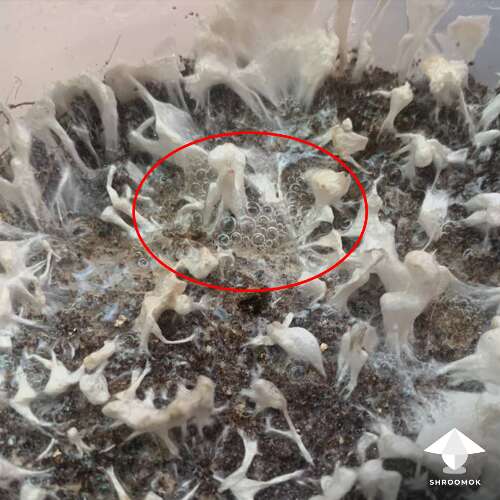
Bubbles after misting cobweb with hydrogen peroxide 3% (Н2О2) After a series of treatments cobweb mycelium should melt and disappear. If this doesn't happen dispose of contaminated cake!
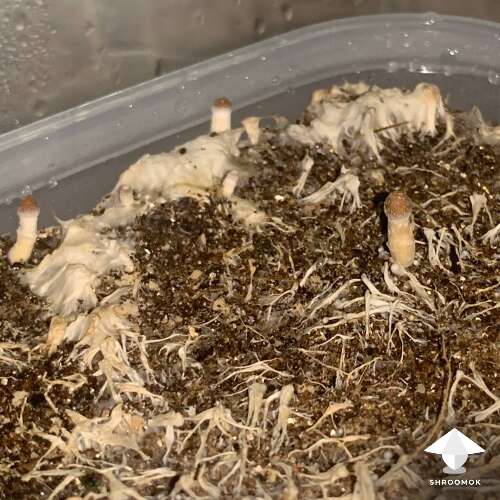
Melted cobweb mycelium After treatment you should take care of the fresh air exchange in growbox/monotub. This can be: extra manual ventilation, fan/cooler or 24/7 aquarium air pump. Check if natural airflow works for your fruiting chamber.
After the very first treatment reduce air temperature in growbox/monotub up to +18°..+20°C (64-68°F) for the next 2-3 days. It helps to inhibit cobweb growth.
Is hydrogen peroxide safe or harmful for mushroom mycelium
It's a common misconception that hydrogen peroxide only affects cobweb mold. In fact H2O2 kills any fungal spores (including mushroom spores) and kills mold mycelium. However H2O2 doesn't kill, but slightly inhibit mushroom mycelium growth. Don't be surprised if you get your harvest 1-2 weeks later
In case of mild contamination many pins and mushrooms may indeed live and thrive afterward!

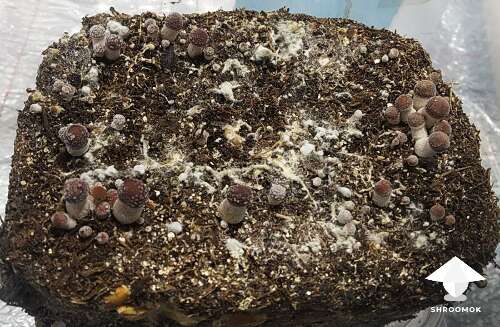
One more example and results of Cobweb Mold treatment
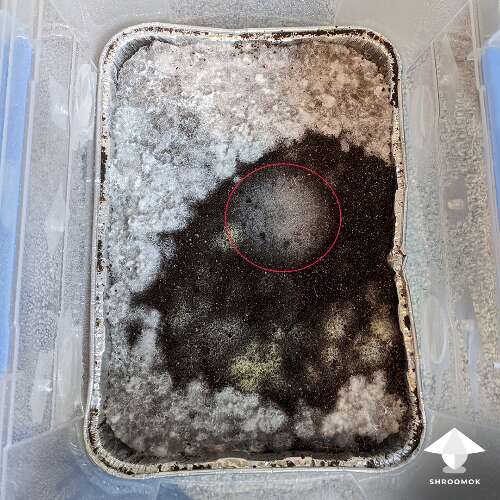
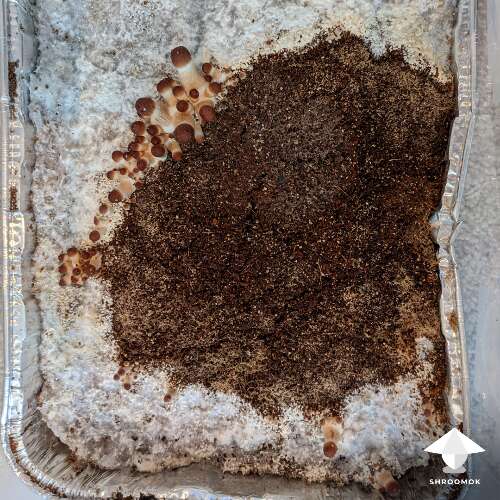
❗️Hydrogen peroxide inhibit and kill cobweb mold, however it doesn't mean it won't come back again. Unfortunately it can be a battle till the end
As a result the most effective method of dealing with all species of mold are preventive measures and disposal contaminated cake. But don't give up if you faced with cobweb contamination!
Take advantage of a tried-and-true tip with H2O2 or salt treatment.
Salt application for cobweb mold treatment
One more effective method against Cladobotryum spp. cobweb is salt application. Most often used in commercial cultivation.
Place a damp paper tissue/towel over the growth to contain any spores that have not yet released. Then you can pour salt (refined, small fraction) over the paper towel. It helps to eliminate the cobweb mold presence in the top layer of substrate
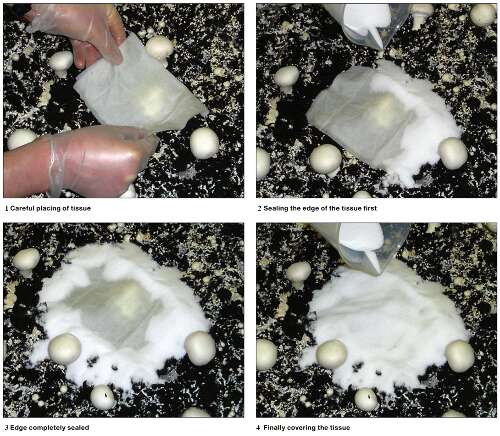
The patches of disease must first be gently covered with damp tissue to prevent the spores becoming airborne.
Then the tissue should be covered with fine grained salt. The salt application should first seal the edges of the tissue to prevent the escape of spores.
Seal the edges completely.
Once the edges are sealed, more salt should be applied to completely cover the tissue and underlying patch of cobweb.
Specific control measures to prevent the spread of cobweb mold
To prevent the spread of cobweb contamination during treatment:
Never mist growbox/monotub with untreated mushroom cake inside! Misting over untreated areas of contamination will result in a massive spore load being spread throughout the crop.
Turn off the air conditioning or ventilation during treatment manipulations likely to disturb mold spores or pieces of mold mycelium (e.g. misting with H2O2 and salt application)
Useful stuff on Amazon to prevent or deal with cobweb disease
Basic stuff for cobweb treatment
Hydrogen Peroxide 3% - 32 oz $9.99
Ultra Fine Mist Spray Bottle - 10 oz $8.99
Sterilised bulk substrate
Ready Bulk Substrate - 5 Pounds - 1 Bag $32.95
Fresh air exchange and additional fanning for MonoTub
Quiet PC Fan with power plug cord $19.99
Fresh air exchange, additional ventilation, air filtering for GrowBox
Quiet Oxygen Pump for 20-100 Gallon - 2 Outlets $15.99
For sterilisation (tools, environment etc)
Isopropyl Alcohol 70% Spray 32 oz or bigger volume $13.95
Clorox Bleach Germicidal Spray 32 oz. $13.98
UVC Light Lamp - Ozone Free $17.99
UV Light Bulb with Base - Ozone, with Timer $36.99
Air HEPA Purifier for Home $99.99
Afterwords
Check out more examples of cobweb contamination in 📸 Cobweb Mold photo gallery
If you find this guide helpful, please support me with cup of coffee on ☕️ buymeacoffee
You can also leave your comments on this page below ⬇️ get help for free on Forum or request Personal Consultation.
Have a happy growing and healthy shrooms!


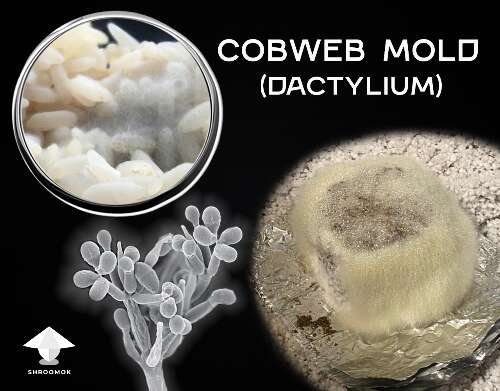
Comments
Add comment